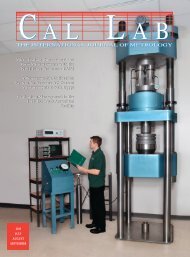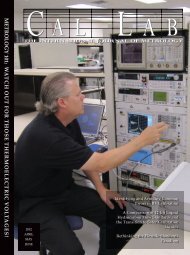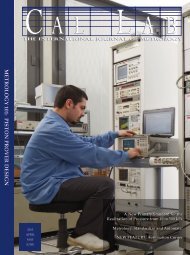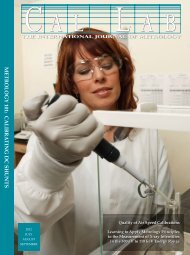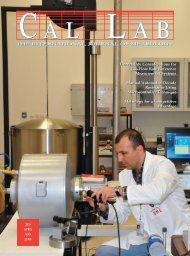Magazine – PDF - Cal Lab Magazine
Magazine – PDF - Cal Lab Magazine
Magazine – PDF - Cal Lab Magazine
Create successful ePaper yourself
Turn your PDF publications into a flip-book with our unique Google optimized e-Paper software.
Effective Communication Between<br />
Customers and Their <strong>Cal</strong>ibration <strong>Lab</strong>s<br />
<strong>Cal</strong> <strong>Lab</strong>: The International Journal of Metrology<br />
Heather A. Wade<br />
<strong>Cal</strong>ibration Officer<br />
NSF International<br />
A customer may send equipment to a calibration vendor for calibration with the expectation of quickly receiving it calibrated.<br />
The only instructions sent with the equipment may be “please calibrate this.” <strong>Cal</strong>ibrations are often delayed because of<br />
missing or incomplete information. Additionally, customers may not receive equipment calibrated for how they intend to use<br />
it. Using the requirements of ISO/IEC 17025 and feedback from calibration vendors, we created a formalized process and<br />
a standardized form for requesting calibration services. We’ve found these to be effective tools to streamline outsourced<br />
calibration and equipment services.<br />
Introduction and Viewpoint<br />
This paper is written from the perspective of an internal<br />
calibration lab which directly services only the departments<br />
within its own company and is also in direct contact with<br />
outside calibration vendors. While it is recognized that<br />
some companies’ communications go through multiple<br />
departments (both for the customer and for the provider),<br />
these experiences and solutions may also be applied to<br />
any lab needing outsourced calibration services. It is<br />
imperative that both the customer and the vendor take<br />
equal responsibility for communicating with one another<br />
to ensure the customer’s requirements are met. Both<br />
the customer and vendor should be familiar with the<br />
requirements of ISO/IEC 17025:2005 section 4.4 Review of<br />
requests, tenders and contracts, 4.6 Purchasing services<br />
and supplies, and Section 4.7 Service to the customer. This<br />
paper addresses common frustrations between customers<br />
and their external calibration labs and offers solutions for<br />
effective communication.<br />
Our Background<br />
In the process of meeting the calibration requirements<br />
of our internal departments, we interact with external<br />
calibration vendors. Our Testing <strong>Lab</strong>s are accredited<br />
to ISO/IEC 17025. While our <strong>Cal</strong>ibration <strong>Lab</strong> is not<br />
accredited on its own to ISO/IEC 17025:2005, it must still<br />
meet the requirements of ISO/IEC 17025. Throughout<br />
our ongoing interaction with calibration vendors, we’ve<br />
both encountered repeated common frustrations and<br />
communication issues. By looking at those issues, we<br />
developed some standardized practices to minimize, and<br />
hopefully eliminate, problems, confusion, and repeat-work<br />
and to ensure smooth, timely, and complete calibrations<br />
and service.<br />
Understanding Our Needs<br />
In the beginning, we thought that just by finding an ISO/<br />
IEC 17025-accredited calibration vendor, sending them our<br />
equipment, and saying “please calibrate this,” that they<br />
would know what we wanted and that our calibration<br />
requirements would be satisfied. In return, we’d get a<br />
calibration certificate and a sticker. It was only after multiple<br />
phone calls, delays, or reviewing calibration reports and<br />
finding that our requirements weren’t being fulfilled that<br />
we realized that we needed to better communicate our<br />
calibration requirements to our vendors. By completely<br />
understanding our own requirements, we were able to<br />
better communicate with our calibration service providers<br />
so that we would receive what was required the first time.<br />
By communicating specific requirements upfront, it has<br />
saved time, money, and resources for both the supplier<br />
(vendor) and the customer (us).<br />
What Were The Issues?<br />
What were the frequent and common issues that we<br />
encountered and what did we need to know?<br />
As part of our accreditation, we’re required to use<br />
accredited calibration vendors. In the beginning, after<br />
finding an accredited vendor, we send the equipment<br />
to them and ask them to calibrate it or give us an ISO<br />
17025-calibration.<br />
Some vendors might call back and ask if:<br />
Do we want an ISO 17025-accredited calibration?<br />
• Do we need to just meet the requirements of ANSI<br />
Z540, MIL STD 45662A, or something else?<br />
• In what units should the data be reported? (e.g.,<br />
the gauge reports in inches of water, inches of<br />
mercury, psig, kpa, but you only need it to report<br />
in psig.)<br />
• Do we want As Found & As Left data?<br />
• Do we need any data or just a Pass/Fail?<br />
36 Oct • Nov • Dec 2011



